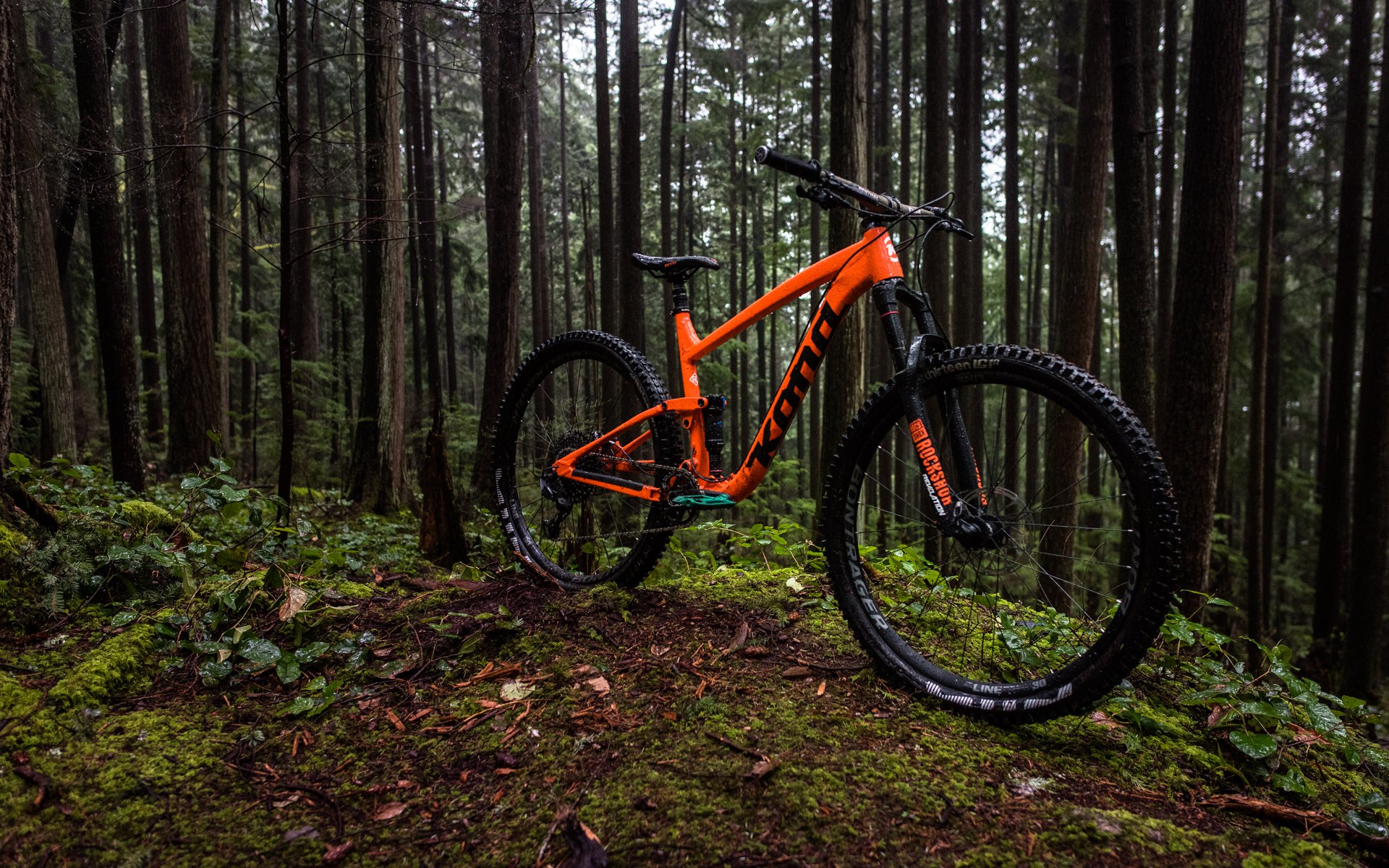
Long-Term Review
2018 Kona Satori 29'er
Satori
I stand the bright orange 2018 Satori DL against a wall and take five steps back. The machine blends the familiar profile and all-business aura of Kona's Hei Hei XC bikes with a utilitarian all SRAM build kit and a seat tube angle (STA) so bleeding edge steep that even incurious riders notice it.
The internet can't get over the 68° head angle but my stimulating experiences with the Kona Process 111 and Process 134 tell me that mountain bikes are more than any single static number on a piece of paper. When asked I'm not shy, I want the Satori to be a Process 111 with a 140mm fork and a water bottle cage. Capable of category-blurring riding and racing shenanigans, ridiculously fun, and with that 'Kona feel'.

The 78.3° STA on a large Satori is a rare case of a major brand shifting the bleeding edge in bike geometry.
The first bike I tested for NSMB.com was a size large Process 134 - with the same travel numbers as this Satori. It isn't the perfect bike for anything, and I much prefer to ride big hoops on technical terrain, but the 27" wheel 134 remains the single most fun bike I've reviewed.
I also have a fair number of hours on some sweet custom-spec. Process 111 bikes. When it comes to truly capable mid-travel rigs that are also sh*t-eating-grin-inducing I'll put the 2014 Process 29'er with a 140mm fork up against anything on the market today.
The Satori's XC-bred pivotless FUSE rear suspension design has very big shoes to fill.
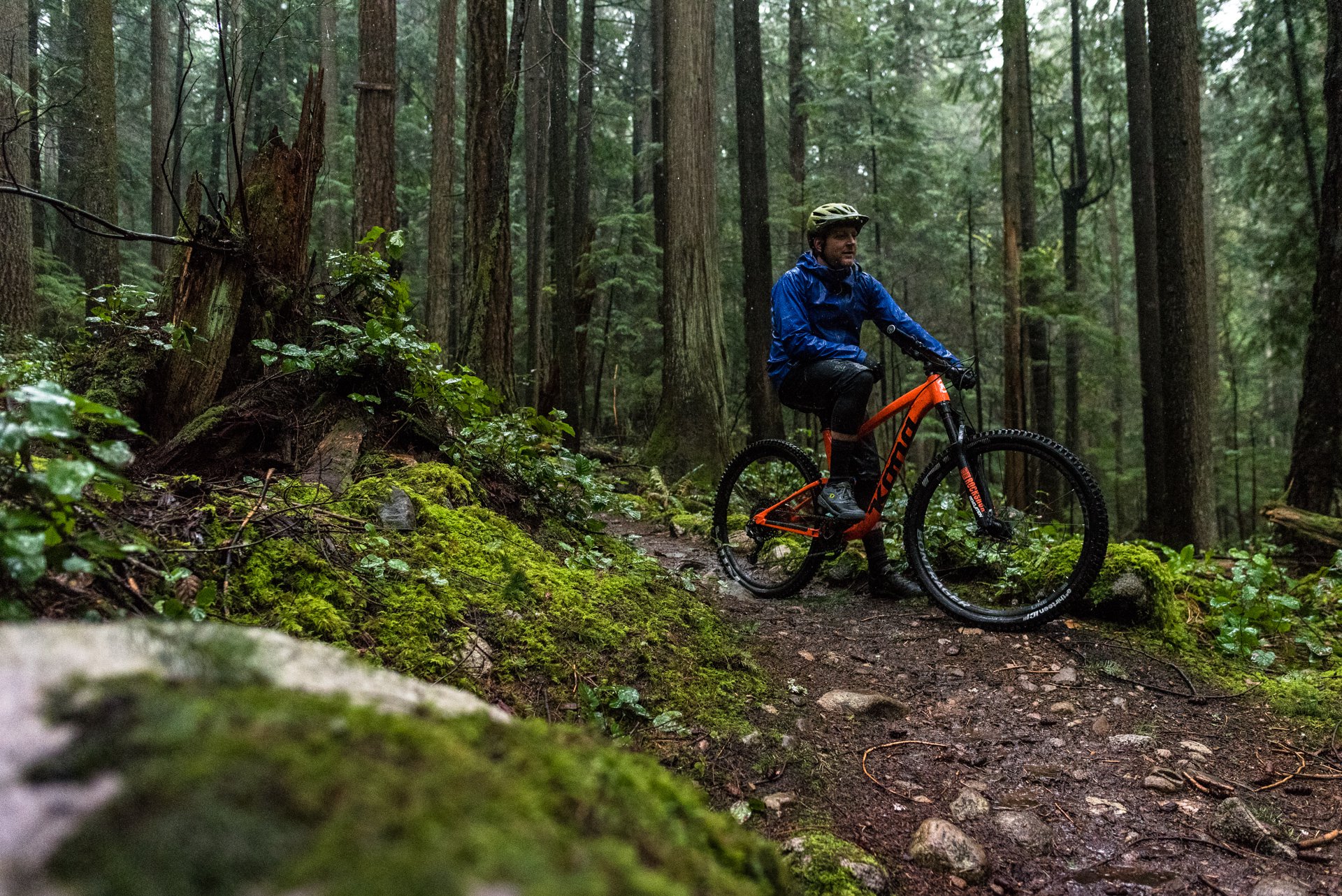
The Satori manages to cut an interesting shape despite sharing the most common suspension silhouete on the market.
The Numbers
After my first seated ride around the block I ran inside to grab a tape measure. I was drafting a quick e-mail in my head thinking that Kona had sent me a medium, accidentally stickered as a large. Nope. That astounding seat tube angle swallows up 475mm of Reach damn quick when I sit down.
For comparison's sake, the 2014 Process 134 with the same, 40mm, stem length and a 15mm shorter reach is significantly longer seated thanks to a 74° STA.
I generally prefer the way a 60mm stem /780mm bar combo puts me a bit more over the front wheel on trail bikes and that's an easy swap so normally this would be a non-issue. This is, unfortunately, where my T-Rex ape-index and 5'9" height come into the equation as a 475mm Reach combined with a longer stem is a bit awkward when I stand up to wrestle the bike up or down technical trails.
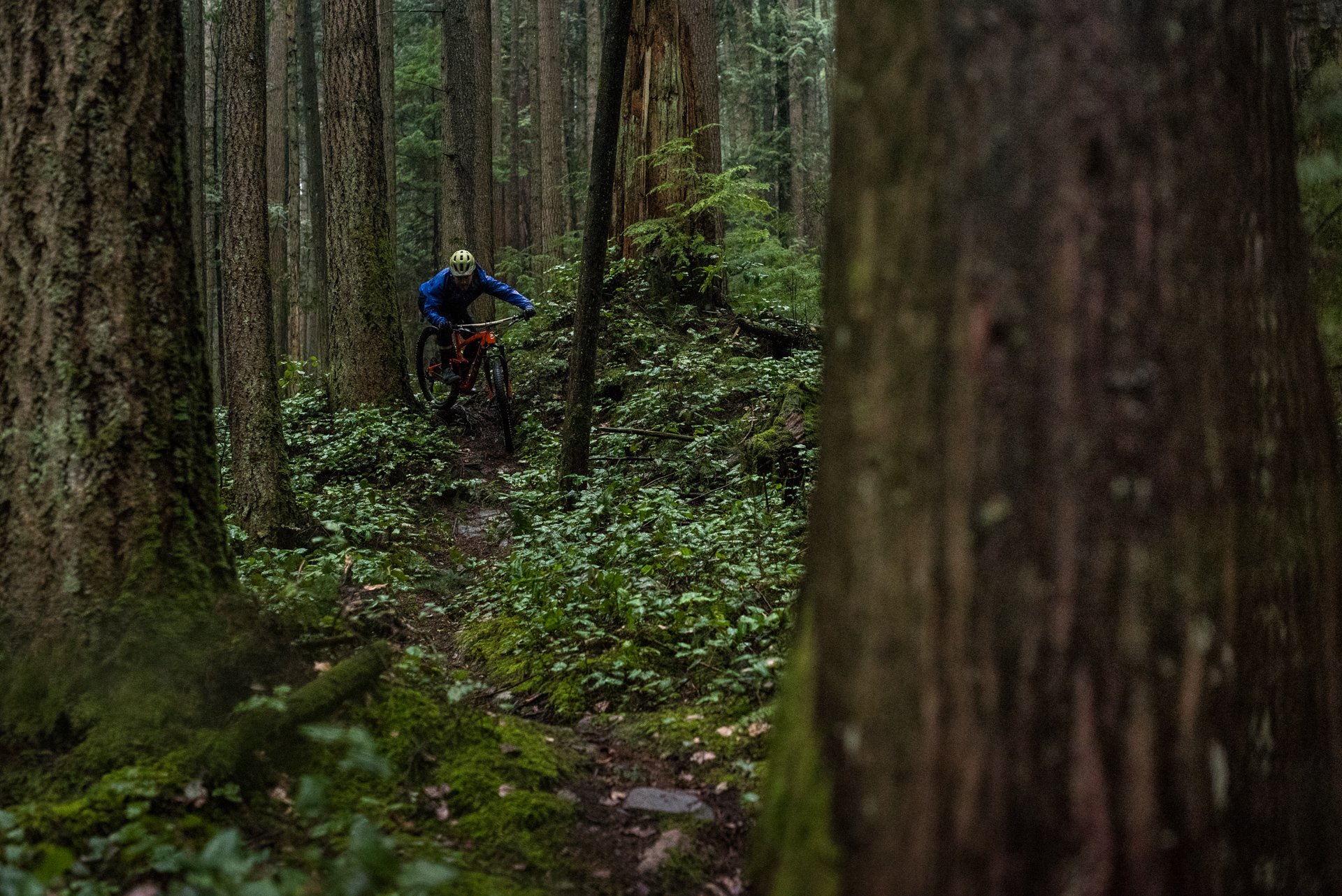
I like the fit of the large Satori when I stand up, climbing or descending.
I ended up moving my seat back as far as possible on the rails, running the stock 40mm stem and swapping the 760mm bar for a 780mm. The fit is great descending and liveable everywhere else.
I'm not willing to write this off to some adage about personal preference or a maxim about test riding a bike before buying it because the standover height and effective top tube limit the upsizing options here. I have a decently long inseam for my height and limited room to lower the Satori's 150mm dropper post meaning there isn't much room for a shorter rider to upsize into the next size of Satori. With longer arms or a narrower bar, I would choose an XL frame but I would have to run a 125mm dropper.
Leaving aside opinions on ideal seat tube angles, I'd need a dropper post with 25-35mm of rearward offset to make the large Satori fit me ideally. For those blessed with longer limbs, Kona could easily sort things out for 2019 by adding 25-35mm of effective top tube length (ETT) for a given size while keeping the 78.3° STA.
Climbing
Kona is on point in comparing the climbing performance of the Satori to their Hei Hei lineup. The steeper the better. I had my easiest clean of the "relentless" local R&R climb and my fastest ever time up the challenging local No Quarter climb on the bright Orange rig. That's despite some fitness setbacks this year.
Riders who love the Hei Hei Trail but wish it came with 29'er hoops will be pleased. This bike could have just as easily been called the Hei Hei Trail 29'er. The fairly short, 1201mm, wheelbase combined with an upright seated body position right over the 68° HTA mean the Satori flips through steep switchback corners easily. The relatively short 430mm chainstays and 40mm stem, position my weight perfectly for uphill traction. The FUSE suspension design is efficient uphill with the shock wide open and traction is faultless at the same time.
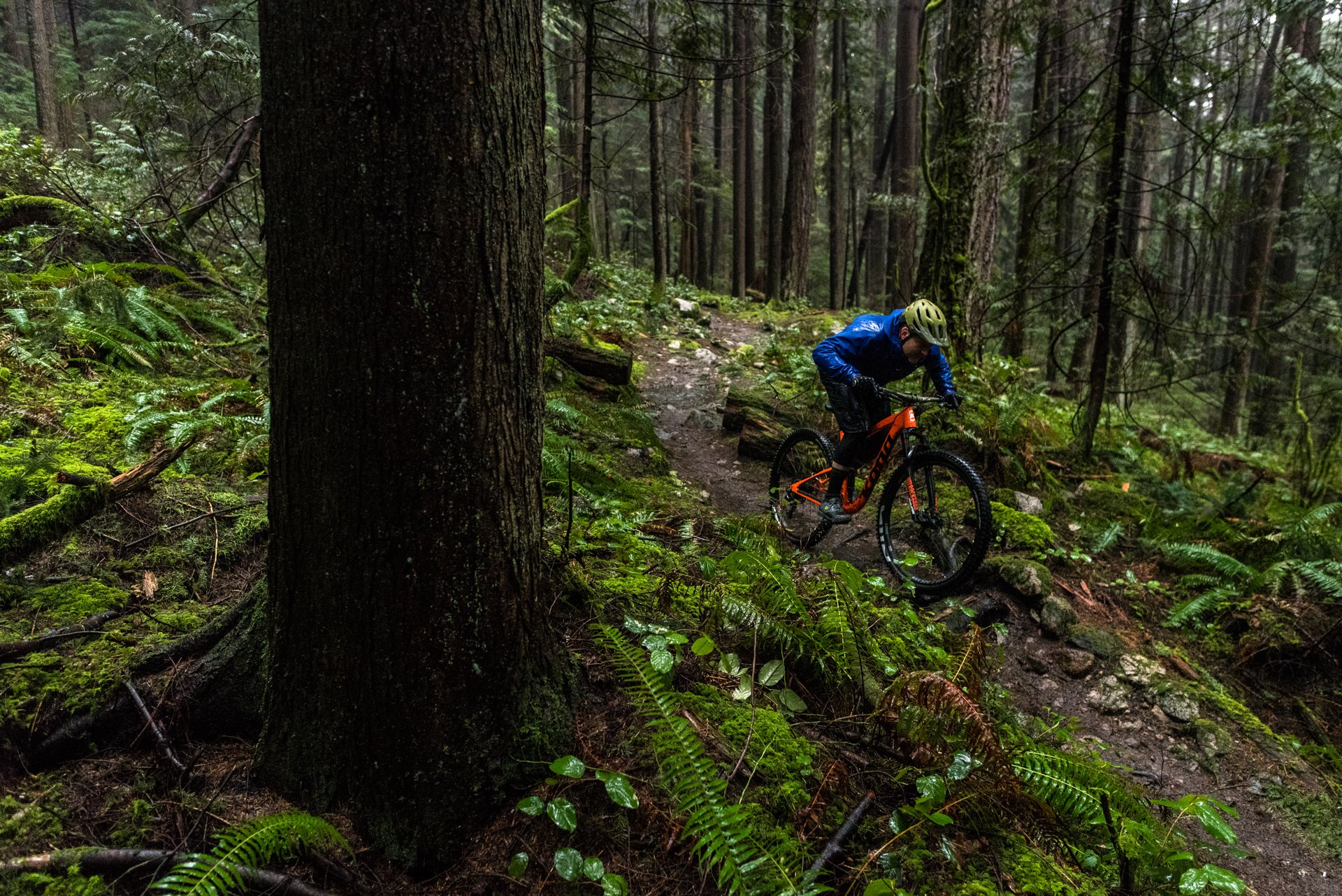
The Satori doesn't have the mojo that makes the Honzo and Process bikes a special kind of fun. It's all business up and down.
The Satori sits just north of 30lbs but decently light wheels and single ply Maxxis tires combined with the geometry make it a pleasant bike to climb. Even running DH rubber to boost the descending prowess in typical North Shore winter conditions the pivot-less FUSE suspension system is impressively efficient.
I'm murdering the poor GX Eagle drivetrain though. It's simple bike fit that an upright seated position works better with higher cadence vs. the sit-back-and-push fit of a position further behind the bottom bracket. I've spent more time in the 50t cog on the Eagle cassette than on any bike I've ridden thanks to the 34t ring up front.
As I mentioned in my first look, I believe the Satori should come equipped with a 30t chainring. This would make more of the cassette usable spinning up medium grades.
Descending
The rear suspension on the Satori is all business. Where those who ride the Process 111 often exclaim that it feels like it has much more travel that Satori only feels like a 130mm bike when smoking a square hit deep in the travel.
That's not to say that the Satori isn't a capable descender, it is simply more at home munching up long miles of green/blue level descents then it is chasing friends down anything steep or nasty. Like riding any bike that sits more towards the XC-edge of the trail category, the Satori needs to be ridden in anger any time I'm trying to hit an aggressive downhill trail or I'm off the back in survival mode.
In this sense, the much-discussed HTA is a non-issue. A 68° HTA on a capable trail 29'er is perfectly on spec. I still wouldn't be surprised to see Kona slack this out to 67° for 2019, hopefully in addition to a longer top tube, as it will help sell bikes to riders laser-focused on that one column on the geo chart.
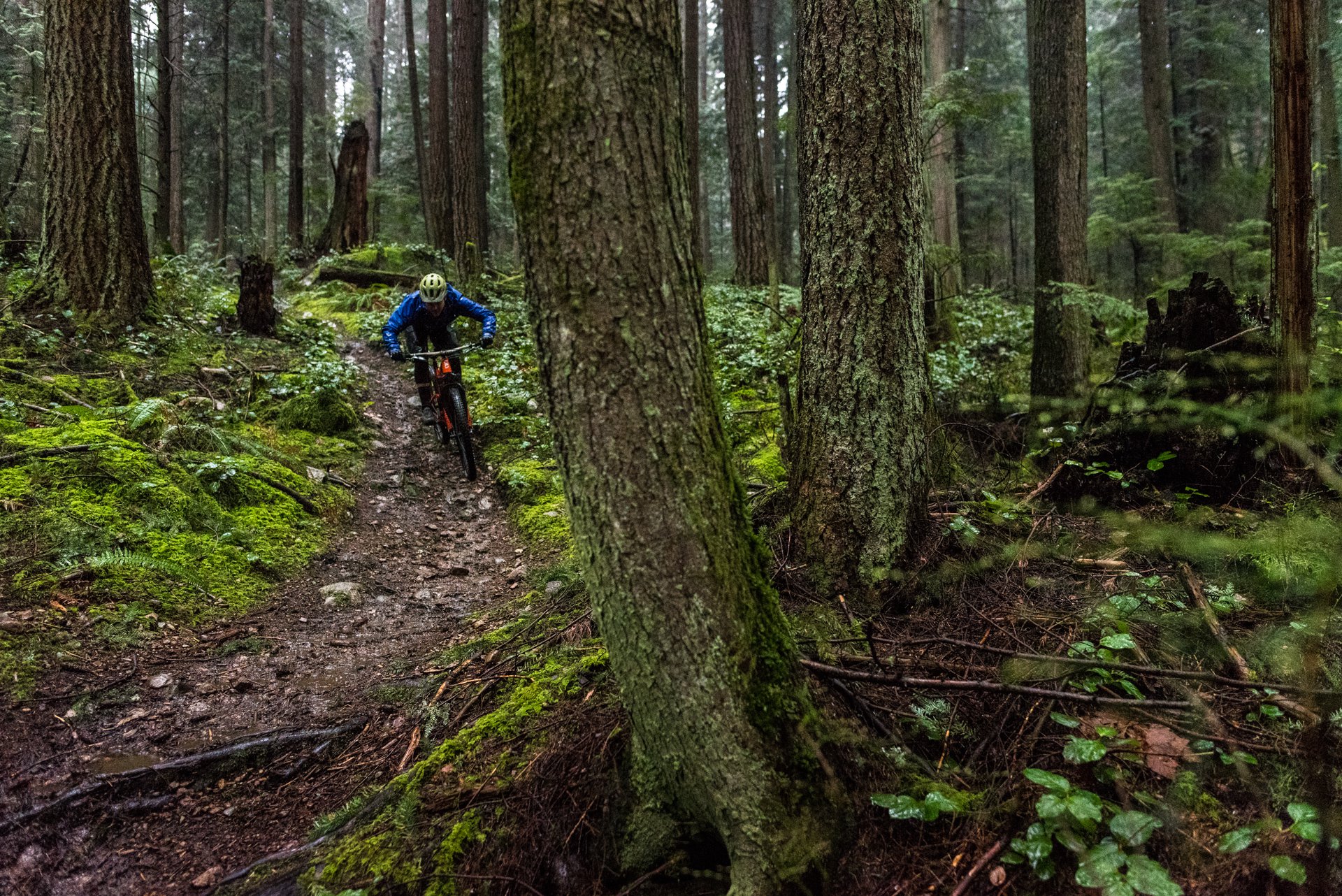
The Satori DL eats up miles of XC trails. It's efficient and comfortable up and down up to moderate-blue trails.
An issue with the surprisingly steep STA is that when I stand up the seat doesn't disappear behind me like it would on a bike with a slacker STA. I've never ridden a bike where the dropper post is such a key component and straight legging a short technical section with the seat up can be a terrifying endeavor. With the dropper post out of the way, the Satori is predictable until trails get nasty.
I’d be primed to try Satori with a DVO Topaz rear shock, the recently announced lower friction 2019 RockShox Deluxe, or even a coil shock to help the FUSE pivotless suspension system initialize more smoothly. My experience with the Topaz on Intense's older double-ring-friendly JS-Tuned suspension leads me to believe it would help re-balance the business-to-fun ratio.

There are a lot of places I've ridden where the Satori could be a great single bike option. The North Shore is not one of them.
Spec - Winning
I wish I could to try the Satori with a 160mm fork as I think it would sweeten the geometry in every situation with a longer ETT, slacker HTA, slacker STA, and better rear suspension initialization thanks to more rider weight over the rear shock. Travel aside, the RockShox Revelation is a surprisingly capable fork.
At 650 USD the Revelation RC is a candidate for the best budget fork on the market. It's easy to set up, smooth out of the box, and stiff enough to elicit no complaints in a 140mm 29'er format. As much as I'd like to see a 140mm Yari on the Satori, for a cheap and easy travel upgrade to 150mm or 160mm, the Revelation is a great choice for the Satori DL's budget. I ran the Revelation with the rebound fast and the low-speed compression wide open. I used the higher end of the air pressure setting for a rider one weight class heavier than myself.
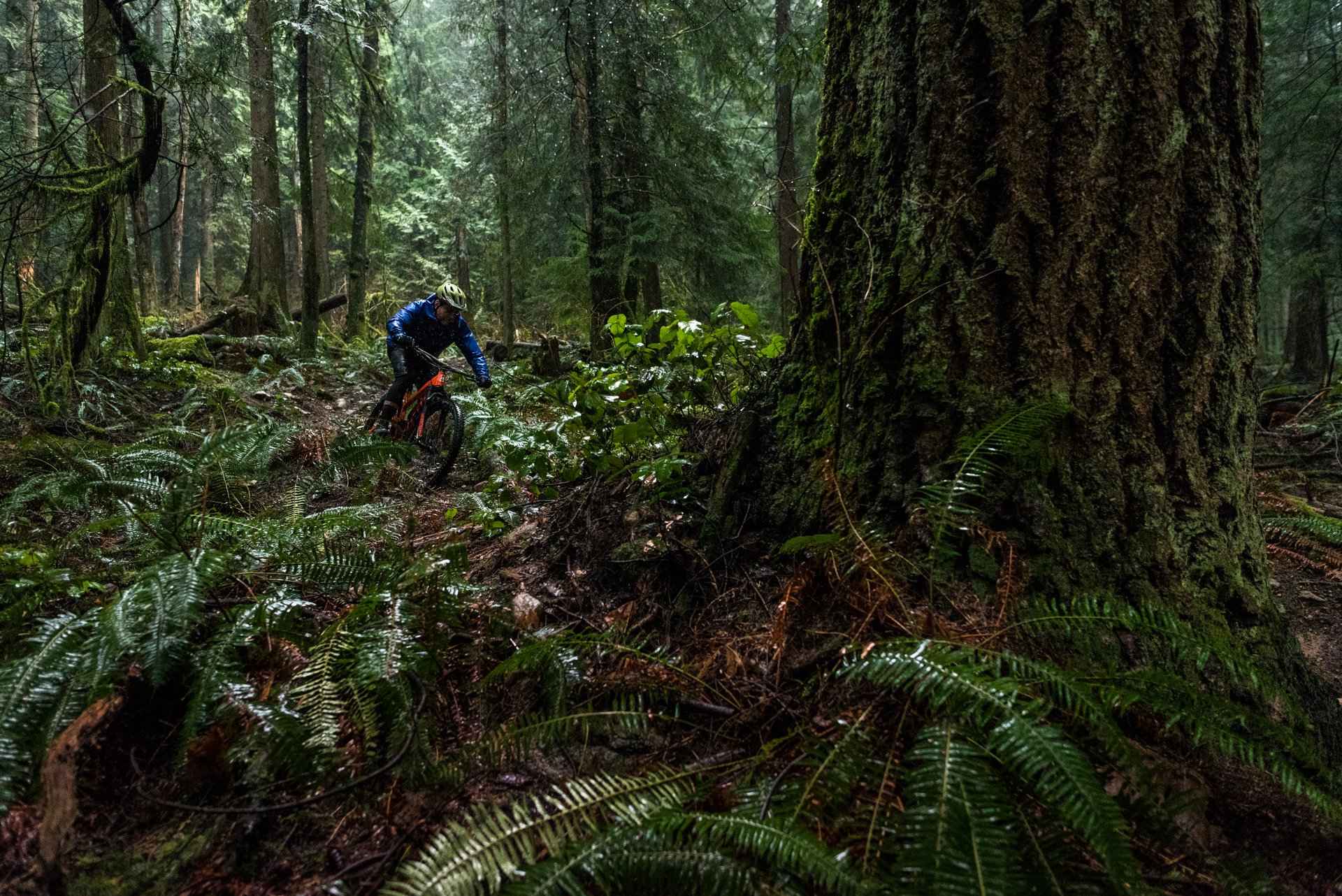
The Satori had the best pair performing set of Guide brakes I've ridden and the GX Eagle drivetrain performed as expected.
The SRAM GX Eagle drivetrain was excellent as expected. GX drivetrains have been spec'ed on higher priced bikes where you'd expect to see XO1 this year but the Satori hits the mid-price for performance bikes and I think it's well appointed.
The Satori came equipped with the best set of SRAM Guide brakes I've ridden. Even with a 160mm rotor rear and 180mm rotor front the power and modulation were consistent with good bite even on wet and steep trails. If this was my bike in addition to a Yari I'd like to see a bigger rear rotor, but I can't argue with the brake spec for the universal market for this bike.
Spec - Losing
There's only one failure when it comes to the spec on the Satori DL. Unfortunately, it's the worst spec choice screw up on any bike I've tested for NSMB and, with the steep seat angle, was a constant drag on performance on any trails that featured rolling technical terrain. The RockShox Reverb dropper post comes with an above-the-bar plunger style remote that is impossible to reach without moving my hand off the grip/brake which renders the dropper post unusable on technical terrain. This remote is a compromise meant to work with a front shifter but a front derailleur can't even be mounted on this bike.
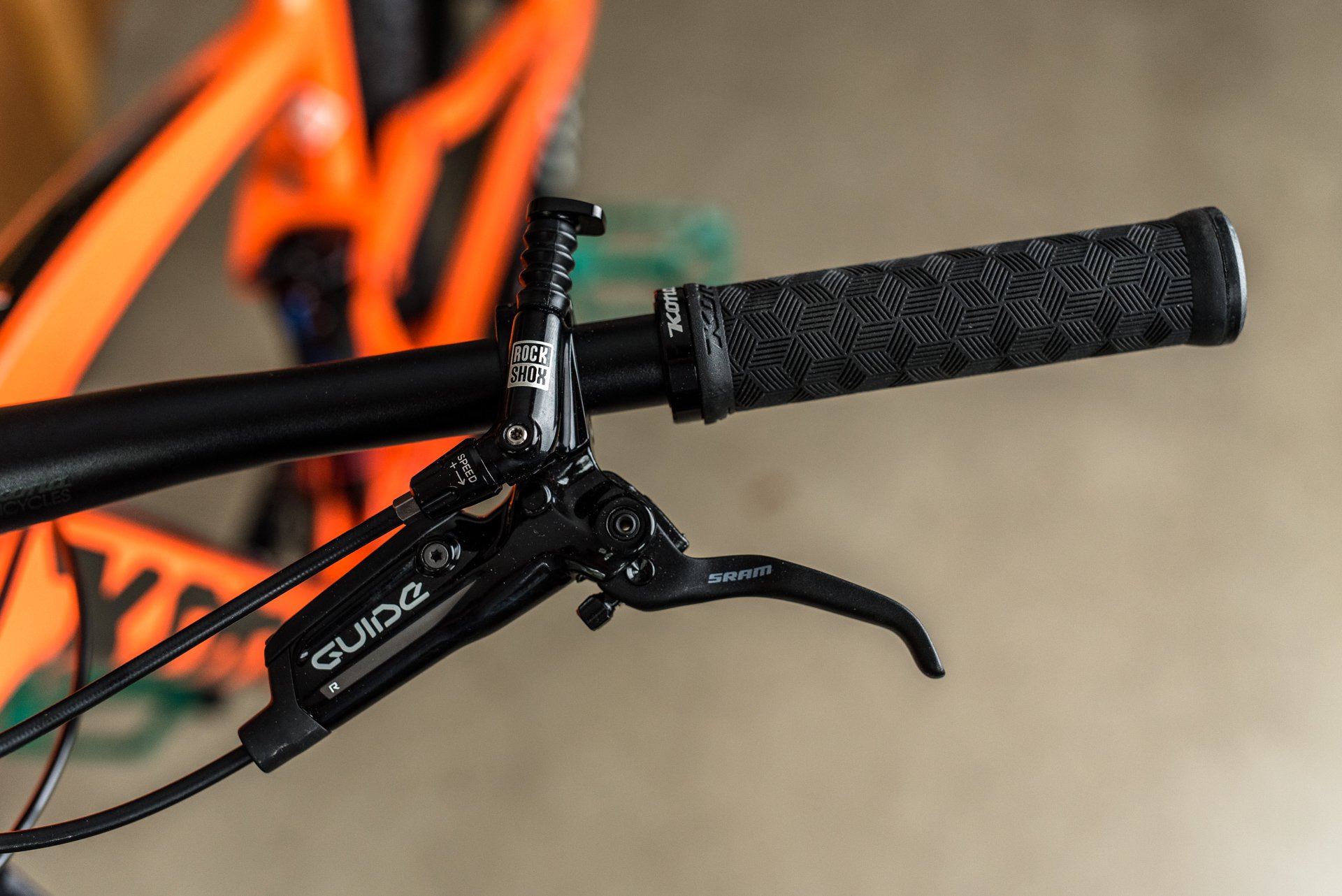
A below-the-bar Reverb plunger remote is bad enough compared to current expectations for dropper post remote ergonomics. The above-the-bar plunger is an absolute spec failure.
I see two key advantages of 1x drivetrains. Firstly, it's much easier to design excellent suspension bikes with a single ring up front meaning better suspension performance from cheaper and simpler platforms. The second key feature is excellent, front shifter-esque, dropper post ergonomics.
There are lots of excellent remote options for cable actuated posts with bad stock triggers, but for this Reverb, it's either an investment in a pricey SRAM remote upgrade or a conversion like Wolf Tooth's ReMote Sustain. At the Satori price point, it's acceptable to see what was previously known as a right-side Plunger remote. When mounted underneath the left side of the bar it's usable on the fly. With the Satori's steep STA an intuitively operated on-the-fly dropper post is absolutely mandatory. What's most depressing about this spec choice is that I highly doubt anyone working at Kona would accept this remote orientation on their own bikes. For example, check out the remote setup in this cool Satori video featuring Jake Hood.
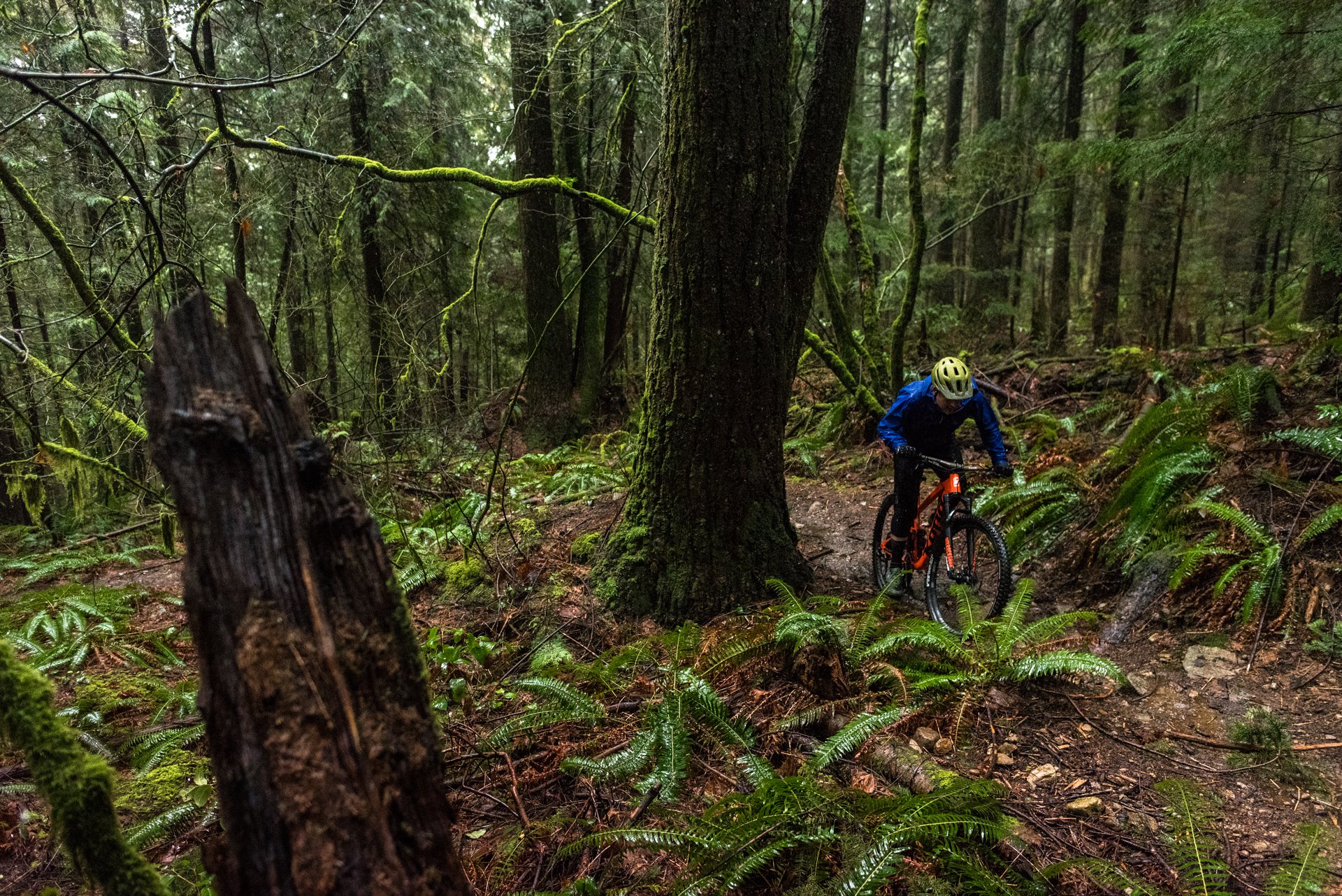
"The FUSE suspension design is efficient uphill with the shock wide open and traction is faultless at the same time."
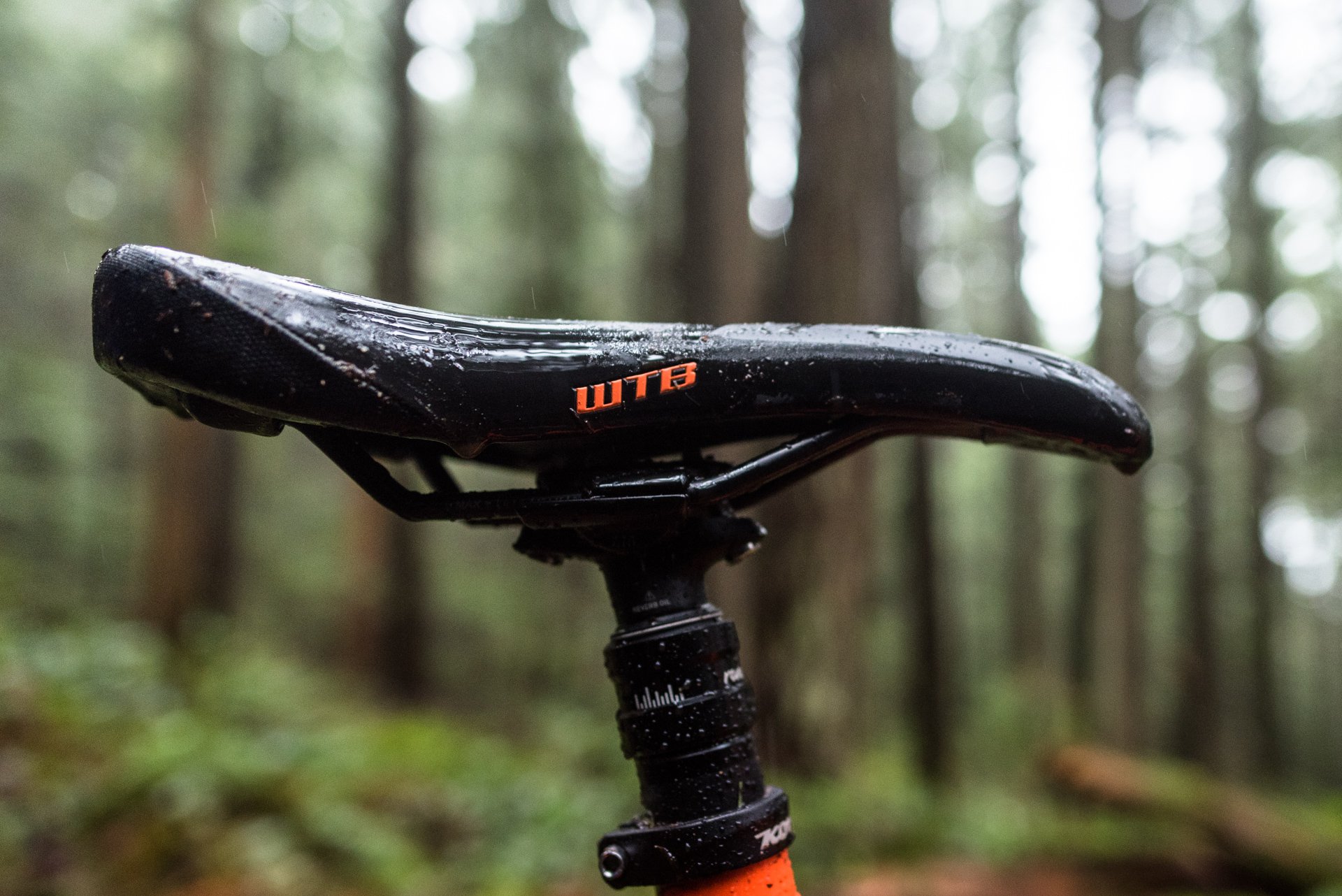
I ran my saddle as far back as possible with the zero offset post. If this was my bike I'd want 25-35mm rearward offset.
I also have to mention that I simply can't comprehend the use of a trunnion mounted shock on this bike. A shock with standard hardware gives customers significantly more options for future shock upgrades with none of the potentially expensive issues a trunnion shock brings to the table - like striping out the shock's expensive-to-replace eyelet assembly when mounting it. Some companies can justify using trunnion mount shocks because of space constraints, especially trying to generate standover by lowering the top tube, but the Satori has tons of clearance.
Target Rider
Even taking the 30-lb weight into consideration, the Satori pedals better than a lot of XC bikes I've ridden without ever having to reach for a shock lockout. It rails steep uphill switchbacks in or out of the saddle and with XC rubber, and some super light hoops I'd race it XC in the participant class.
In my mind, the target audience for this bike is anyone who's been hoping for a 29'er version of the Hei Hei Trail or a more forgiving Hei Hei 29'er race bike. I definitely wouldn't concur that it's the "ultimate all-around machine" and don't note the "Process derived heritage". Assuming the 78.3° STA, and general bike fit works physiologically then with the addition of a new dropper remote the Satori is an awesome bike within that box.
On that note, anyone hoping that seat tube angles will continue getting steeper should try and throw a leg over a Satori.
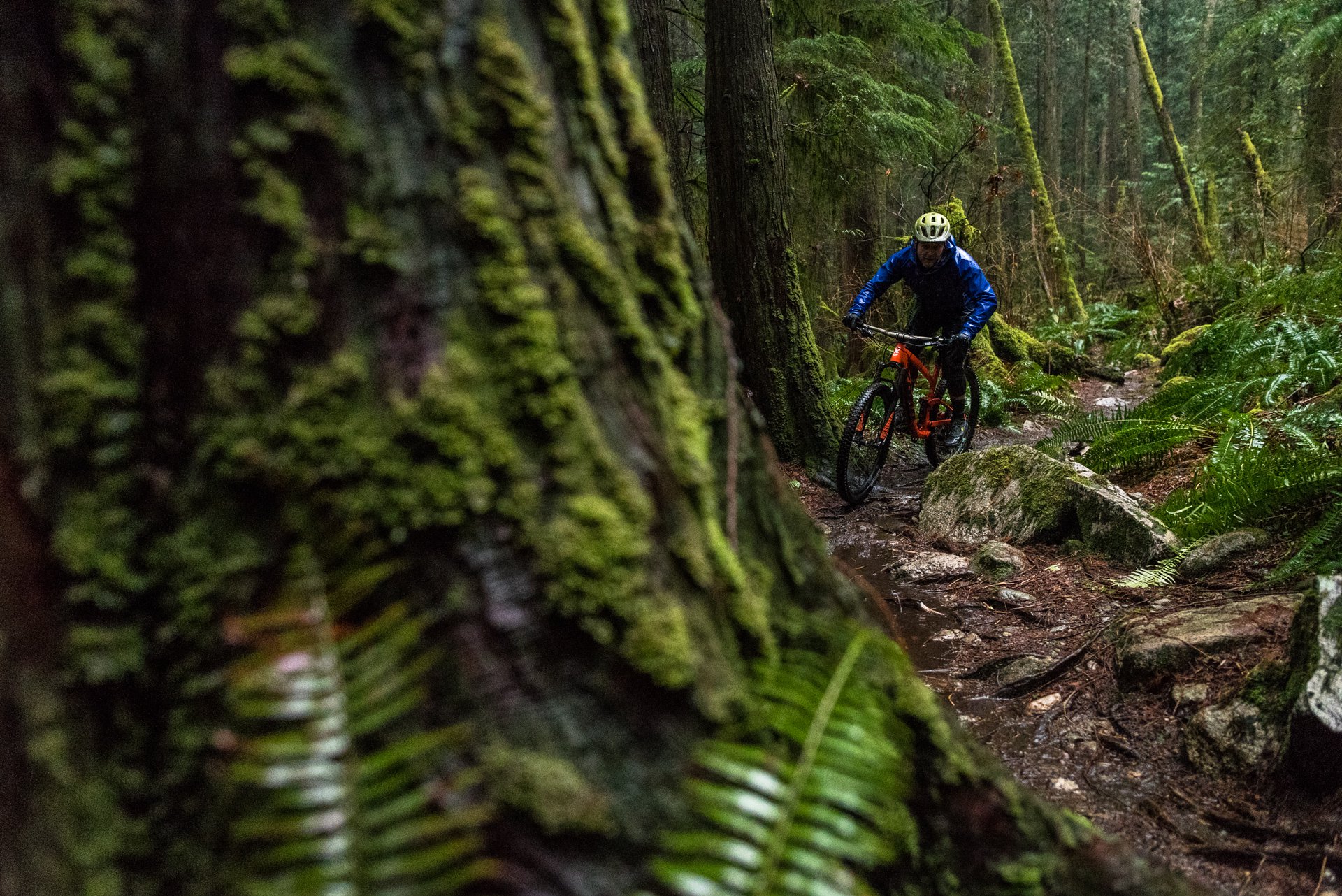
In general, I like the 2018 Satori but I'd still buy a Process 111 every day of the week.
With the 150mm dropper post bottomed the Satori is good on smoother descents and capable of being ridden down more technical trails but it lacks the fun factor of Process models with similar geometry like the 111 and 134. Two of the most fun bikes I've ever ridden. Riding the Satori makes me that much more morose about the Process 111 retirement from this category.
Put another way, the only advantages the Satori has over a 140mm-forked Process 111 are an in-frame water bottle mount, a lighter frame, and firmer pedaling with the rear shock open. It's hard to believe that Kona couldn't have split the standover difference with the Satori and mated an in-triangle bottle with the unique layout of the 111. I can always reach for a climb switch on the road.
For my 3,500 USD | 4,500 CAD I'd be hunting down a clearout Process 111 or throwing a leg over the new Process 153 29'er see how it performs on tight trails and all day epics.
Anyone looking for the steepest in class STA and a longer travel XC bike can grab all the information on the Satori here.







Comments
Dave Smith
6 years ago
Shout out to Andrew and Niels for coming out to shoot in a monsoon.
Reply
Vincent Edwards
6 years ago
I did get to spend some time on the 111, right before they cut it from the line. Super fun well balanced bike- I wish I had bought one years ago. I ended up going with a tallboy3 as it’s as close to a carbon 111 as I could get. (And I’m super happy with that decision, 68 degree HA and all. My biggest gripe is the 73degree STA, but pushing the saddle forward mostly solves this... measurement shows I have a 74.5 Effective STA)
I’m glad you put so much focus on describing the dynamic effects of that steep STA. It sounds like a 75 degree STA would have made you much happier. I hope you do get a chance to put the longer fork and dvo shock on this bike and do a follow up.
I would love to see bike reviews measure actual STA at their saddle height. If a standard for measuring could be agreed upon, this would be great information to have. What’s printed in geo charts is very arbitrary
Reply
Andrew Major
6 years ago
Thanks Vincent, it’s interesting how much a Dropper post becomes a key consideration as seat angles get steeper. I used to be happy with a 125mm dropper but once the STA hits 76+ I’ll take a 150mm+ post every time.
I feel like STA will settle between 75-77. I hope most companies adopt size specific geo where the real STA gets steeper as frame size increases.
Anecdotaly, the further ones legs put them from the BB shell the more they prefer a steeper effective STA.
Reply
fartymarty
6 years ago
Andrew, great review.
When I first read about the Satori I wonder if a -2 or -2.5 head set with longer forks would sort things out. This way the front would stay the same height but with more fire power upfront. This however may just upset the balance between the front and rear. It would be good to hear your thoughts.
I never got to ride a 111 and it does seem a shame they ditched it from the line up as this is exactly the FS bike I am after. Looks like I may need to search out a used one.
Reply
BadNudes
6 years ago
By slackening the head angle with and angleset you'd actually be lowering the front end a bit, and I think that would exacerbate some of the quirks Andrew highlited with this bike; The STA would get steeper, the ETT would get shorter, reach would get longer. Oops, I missed the 'with longer forks' bit, that would preserve geo for the most part (aside from HTA), and could be a great option
I'm not sure if it's possible with this bike, but I think a better option would be offset shock bushings which would slacken both HTA and STA, lengthen the ETT , and shorten reach allowing for a 50 or 60mm stem.
Reply
Andrew Major
6 years ago
Honestly, I tag the pedals enough that adding 20mm to fork travel would probably be a win in every sense, including shortening the Reach a bit so I could switch to a 50mm stem, lengthening ETT, slackening STA and HTA a bit, lengthening wheelbase, and putting my weight over the shock a bit more for initialization.
Reply
fartymarty
6 years ago
Andrew - are you long term testing the bike? If so it would be interesting to see how these tweaks play out. Longer fork and offset bushes would be an interesting combo to get the STA just right.
Reply
Andrew Major
6 years ago
I alluded to it in the review but there’s always a balance of article length vs. attention span that I’m pushing up against. I really appreciate the comment section as an opportunity to illuminate and reconsider my experiences.
If the Satori had a 140mm Yari and a cable actuated post with a bad remote then I would have bumped the fork travel up 20mm (~$50 part) and installed a e13 TRS+ match maker remote I have at home as part of the review.
Along with a 20mm wider bar and a 10mm longer stem I don’t consider those unreasonable expenses to dial in a stock bike to my exact preference.
My experience with my Stache re-review was such that I didn’t seriously consider swapping the fork, dropper post, and shock to try the Satori frame under a set of circumstances where I think it could potentially be awesome. As was rightly pointed out to me with the Stache, this is a Bike review NOT a Frame review. It’s not realistic to expect a rider to buy this bike and then swap major components.
If Kona sent me a large Satori frameset for review I believe that my experience, transferring over my kit from my personal rig, would be very different just as it was with the Stache.
Reply
Michael
6 years ago
Putting a 150 and a -2º angleset on this bike would make this a beast and preserve existing geo for the most part. It would absolutely be the first thing I would do.
Reply
Andrew Major
6 years ago
I disagree profusely. As I said in the article the 68° HTA isn't an issue - in fact, it suits the overall characteristics of the Satori just fine.
However, what is an issue is how short the top tube feels seated compared to the Reach when standing. As I noted, seated this feels like the smallest bike I've tested for NSMB - it is a size Large - and I am 5'9" with T-Rex arms.
The issue with the -2° angleset is it is going to make that short effective top tube feel even shorter. It will shorten the Reach at the same time allowing you to run a longer stem but I'm one of the few people I know that still prefers a 60mm stem for trail riding and because of the long seat tube sizing up to an XL isn't an option.
One nice thing about the -2° angleset with a 160mm fork is it would lengthen the wheelbase a fair bit. The FUSE is an obviously XC derived suspension system so at the end of the day I don't know if the Satori could ever be "a beast" but aside from the fit issues I certainly agree it would be fun to try.
...
I have ridden a Process 111 with a -1.5° angleset, a 150mm fork, and a Cane Creek IL rear shock - if you're looking for a hilarious sleeper "Beast Mode" bike.
Reply
Cr4w
6 years ago
So you're saying that during steep burst climbs because of the steep STA the seat is more underneath you and in the way?
For these super steep STA bike how much more reach do you think they need per size to get back into balance? 10mm?
Reply
fartymarty
6 years ago
By my calculations with a 30" seat height (similar to what I use) you lose about 40mm on seated reach (butt to bar) with a 3 degree change in STA. I would say this is quite significant.
Does this then mean a 510mm reach bike (XL) feels like a 470mm reach bike when seated?
Reply
Andrew Major
6 years ago
I mention 25mm-35mm a couple times.
I think for the same TT feel seated it will be the larger number but I think for the best feel overall with the more over the BB riding position a 25mm increase would be perfect.
Through my experiments, just talking about seated climbing a 70mm stem felt like what I’m used to but a 60mm stem worked best with the bike.
At 5’9” / T-Rex arms that was just too long (Reach) standing for these setups.
I’d like to read a review of the fit from someone my height with just long enough legs to run the 150mm post and wicked long arms (plus longer torso).
Still, 5’9” and the large feels small (seated). Maybe 78.3 is just too steep for STA?
Reply
fartymarty
6 years ago
Maybe we have finally got to the upper limit for STA as we have for HTA. From all I have read 75-77 is a good range for STA.
Reply
Andrew Major
6 years ago
Cr4w, to answer your other question: I find the dropper post is a vital component climbing and descending. Anytime I’m riding the Satori out of the saddle I want the post down or it’s in the way.
Reply
Cooper Quinn
6 years ago
As a tall person, aren't you vehemently opposed to the new steep STAs?
Reply
Cr4w
6 years ago
In theory I should like it. At full extension I should finally be in the right spot. Presumably there is such a thing as too steep but I haven’t come close to that yet. I just bought a bike with a 78’ ESTA so I’m about to find out.
Reply
Cooper Quinn
6 years ago
[something something femur length]
Reply
Cr4w
6 years ago
Agreed. But so far that hasn't been an issue because of slack ESTAs. So far the rearward effect of a long inseam has outweighed the long femur issue. It's totally possible we are about to reach a tipping point.
Reply
Cr4w
6 years ago
Agreed. But so far that hasn't been an issue because of slack ESTAs. It's totally possible we are about to max out.
Reply
Cr4w
6 years ago
In theory I should like it. At full extension I should finally be in the right spot. Presumably there is such a thing as too steep but I haven’t come close to that yet. I just bought a bike with a 78’ ESTA so I’m about to find out.
Reply
Vik Banerjee
6 years ago
9.8 makes a dropper with a 1" setback head. I'm using them to tame the steep STAs on new bikes so I get the bike to fit well seated as well as standing and get an efficient pedalling position for rolling terrain as well as uber steep climbs. Although if STAs keep "progressing" I'll have to buy a custom frame in a year or two to get a reasonable fit!
I've got a 34" inseam so I am one of those long legged riders that does not love a steep STA.
Reply
[user profile deleted]
6 years ago
This comment has been removed.
Andrew Major
6 years ago
Hi James,
Have you ridden anything in the STA ballpark of the Satori? There are a few bikes out there now and I'm genuinely curious to talk to someone else who's ridden one.
I agree with you in general and have enjoyed bikes ranging from about 73.5° to just north of 76° in the last year. This is the first bike in years* where I've had issues dialing in stem length to make ETT and Reach work for me.
*In the past I've ridden bikes I couldn't make fit where the STA was so slack and the Reach so short that I needed a super short stem for seated climbing and a long stem for descending.
Reply
Cr4w
5 years, 11 months ago
Are you longer in the shin than the femur and would this account for the difference?
Reply
Andrew Major
5 years, 11 months ago
If anything I’m the opposite (proportionally longer femurs).
I’m not clear what difference you’re referring to?
If it’s related to James’ comment then he never quantified what the STA he’s riding (conserves energy / mitigates back pain) actually measures. There’s a big difference between 74 and 76. There’s a big difference again between 76 and 78.3.
Reply
Morgan Heater
6 years ago
I love my process 134.
They should have kept making it, just added a gearbox, and made a special water-bottle to sell with the frame to silence the whingers.
Reply
John Forsythe
6 years ago
Great review. I really wish all bike reviews could be this pointed.
I have that awful top of bar Reverb remote on my Jeffsy. I effing hate it. To switch out, I need to get a new clamp for my front break and then a new remote (WolfTooth). What a pain. More than once I've fumbled around trying to find it. I get the tidy bars aspect of it for 2x drive trains (ditched mine for a 1X), but its pretty awful.
Reply
Andrew Major
6 years ago
Thank you John!
Another option would be to run the Wolf Tooth ReMote on a hinged clamp and rig your above-bar Reverb plunger up to a hydraulic actuator that fires an air horn...
...then every time someone before/after a ride starts talking about how clean integrated controls look you can drown them out with hydraulically actuated wailing.
Reply
John Forsythe
6 years ago
Andrew, that sounds like a really good idea. Problem with it, though, is that I'd have to bleed the reverb remote after every ride to get the airhorn to work!
Reply
Andrew Major
6 years ago
I have no words...
Reply
[user profile deleted]
6 years ago
This comment has been removed.
thehfk
6 years ago
Great review, if a bit of a bummer.
I also want the Satori to be a 111 DL replacement with a playful character but it sounds like it was lacking in stability. If I understand you correctly, the STA makes a bike with two personalities: an uphill ripper and a scary AF descender. Is there any fun in there? The new Kona video seems to hint it can be thrown around easily. If not in its stock incarnation, what about with a taller fork?
Reply
Andrew Major
6 years ago
The Satori is in no way a scary AF descender with the seat post out of the way. It's just all business and definitely rides towards the XC end of the trail bike category compare the up-for-anything surprise that is the Process 111.
I've addressed what I think of running a longer fork in a few comments above.
I've seen videos of truly talented bike handlers shredding hard lines beautifully on XC bikes - that's not me. I consider myself a decent bike rider but I definitely need a hand-up from whatever rig I'm riding.
Reply
thehfk
6 years ago
Fair. What do you think of this as a BCBR bike with a set of lighter wheels and perhaps a couple of other upgrades?
Reply
Andrew Major
6 years ago
If I was doing BCBR I'd pick up a Kona Hei Hei 29'er CR/DL and never look back.
120mm front / 100mm rear with a 75° STA / 68° HTA and a 455mm Reach in my size. It has an Eagle build, Guide brakes, and the proper SRAM 1x lever for the stock Reverb.
I'd leave the Ikon on the back (for the summer), slap a 2.3" DHF up front, and put on a wider bar and I'd ride it anywhere I'd ride this Satori only faster.
Reply
Klaus
6 years ago
Why don't you simply mount the Reverb remote below the bar? Was the long time test too short to afford a minute? ;-)
Reply
Andrew Major
6 years ago
Are you asking a serious question, trying to troll me, or am I missing a joke?
Any way, it’s covered in the piece if you read it. To mount a Reverb plunger remote below the bar you need to use the above-bar remote meant for the other side.
I.E. Kona would have needed to spec the RH remote (and mount it underneath the LH side) not the LH remote.
I guess I could have taken the time to single speed the bike and mounted the LH remote under the bar on the RH side instead of a shifter...
Reply
John Forsythe
6 years ago
You sure could have. Then this would be just like every other review where they swap half the parts on the bike and then call it amazing. I liked your 'reviewed as is' approach. We all know that bikes can be tweaked and massaged to perfection, but that kind of wasn't the point of this, was it? :)
Reply
Andrew Major
6 years ago
As I said in the article, if it was a post using a regular cable I would have swapped the remote for my preference without a second thought.
My comment above was being cheeky i.e. the only way to run the LH plunger remote under the bar is to run it on the RH side... where there is currently a shifter... so the only way I could do as Klaus suggests is to turn the bike into a single speed.
Reply
Please log in to leave a comment.